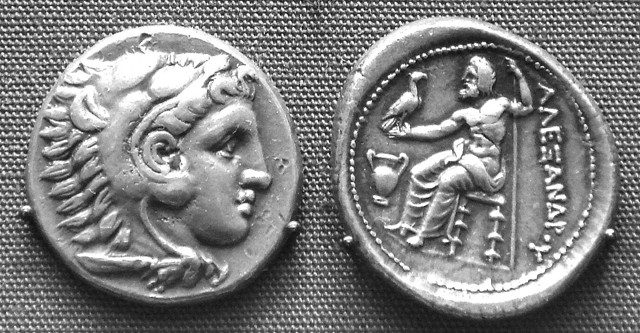
by U.S. Geological Survey Friday, January 30, 2015
Florence C. Katrivanos, a mineral commodity specialist for the U.S. Geological Survey, compiled the following information on silver, an ancient metal with many modern applications.

This early-third-century-B.C. silver coin depicts Alexander III of Macedon, better known as Alexander the Great. The Macedonians also used silver medicinally, to treat battle wounds. Credit: The British Museum.
Silver, one of the eight precious or noble metals, has been used extensively throughout recorded history for various medical purposes, ornaments and utensils, and for its intrinsic value as the basis for trade and monetary systems. Silver has played a significant role in world history, financing a Greek victory over the Persians in 480 B.C., helping Spain become a world power in the 16th and 17th centuries, and helping fund the Union forces during the U.S. Civil War, to give a few examples.
Silver occurs as a native metal; in sulfide ores of copper, lead and zinc; and sometimes with bismuth and antimony. Silver is always present in ores containing gold. The Silver Institute estimated that, in 2013, about 29 percent of global mined silver came from silver ores, 38 percent came from lead-zinc ores, 20 percent came from copper ores and 13 percent came from gold ores.
Silver’s properties include its ability to endure extreme temperatures, its high reflectance of light, its thermal and electrical conductivity (the highest of all metals), and its strength, malleability and ductility. Demand for silver arises from three areas: industrial applications (in electronics, brazing alloys and solders, photography and other uses), investment (including coins and bars), and silver jewelry and decor (including silverware).
Silver-halide X-rays were long the standard, but are now being replaced by digital imaging technology. Since 2000, demand for silver in photographic applications has also declined owing to the use of digital photography. In 2013, uses in electronics accounted for 42 percent of U.S. silver consumption; coins and metals for 35 percent; photography for 13 percent; jewelry and silverware for 7 percent; and other uses for 3 percent.
Silver is also used in solar power generation: 90 percent of crystalline silicon photovoltaic solar cells use silver paste. On windows, a transparent layer of silver reflects up to 95 percent of sunlight, saving energy. In water purification, use of silver eliminates the need for corrosive chlorine.
For more information on silver and other mineral resources, visit: http://minerals.usgs.gov/minerals.
World mine production of silver in 2013 was estimated to be 26,000 metric tons. Mexico was the world’s leading producer (19 percent), followed by China (16 percent) and Peru (14 percent).
U.S. apparent consumption of silver in 2013 was estimated to be 6,620 metric tons. Significant sources of imported silver include Mexico (53 percent) and Canada (28 percent).
Three silver mines produced 18 percent of U.S. silver production; the remainder came from 39 mines that mainly produced other metal ores but recovered silver as a byproduct.
Alaska led the nation in silver mine production, followed by Nevada, also called the “Silver State.”
Herodotus noted that Persian kings would not drink water unless it was transported in silver containers, which kept it pure for days.
In the early 1900s, doctors used complexes of silver and protein, both orally and as injections, for antimicrobial therapy.
Pure silver is too soft for use in jewelry and ornamental applications and is thus alloyed with copper to form sterling silver.
© 2008-2021. All rights reserved. Any copying, redistribution or retransmission of any of the contents of this service without the expressed written permission of the American Geosciences Institute is expressly prohibited. Click here for all copyright requests.